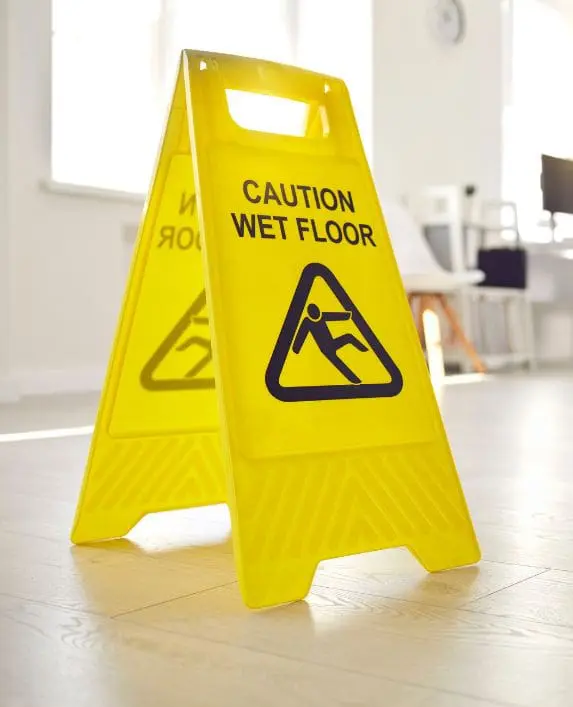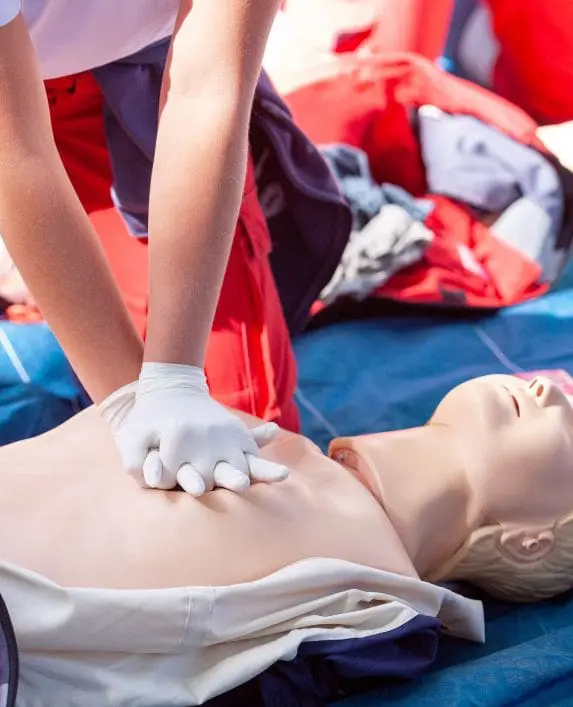What you will learn
This online First Aid at Work Refresher Training ensures you can confidently and knowledgeably take charge of first aid arrangements in the workplace.
By the end of the course you will be able to:
- Understand the importance of promptly assisting injured or ill individuals within the workplace through first aid training.
- Familiarise yourself with the objectives of first aid, your legal obligations, consent procedures and the essential duties of a first aider.
- Maintain calm and accurately evaluate emergency situations, identify potential hazards, prioritise treatment and ensure thorough post-incident cleanup and infection prevention.
- Gain knowledge about the respiratory system, levels of consciousness, causes of unconsciousness, airway maintenance, breathing assessment, recovery positioning, CPR techniques, AED use and the critical chain of survival.
- Understand epilepsy, recognise partial and generalised seizures and provide the right first aid treatment.
- Understand what asthma is, differentiate between mild and severe attacks and deliver the appropriate first aid intervention.
- Recognise diabetic emergencies and provide the correct first aid treatment.
- Identify choking and deliver first aid for minor and severe cases, addressing potential hypoxia.
- Identify and treat various wounds, control bleeding and manage shock.
- Identify signs of anaphylactic shock and administer proper emergency first aid treatment.
- Recognise signs and symptoms of head injuries and understand the appropriate first aid treatments.
- Identify the common signs and symptoms of different types of fractures and learn effective first aid responses.
- Provide immediate treatment for poisoning and understand how poisonous substances enter the body.
- Treat a range of minor injuries such as contusions, cuts, grazes, splinters, nosebleeds, eye injuries and sprains and strains.
- Administer first aid for hyperventilation, including knowing the latest treatment methods.
- Respond to a suspected stroke casualty by understanding various causes, signs and symptoms.
- Recognise and take effective first aid action if you suspect a spinal trauma.
- Understand the circulatory system and heart function, the effects of significant blood loss, what a heart attack is and the appropriate response during a cardiac arrest.
- Identify unique characteristics of various burn types and administer appropriate first aid treatment.
Modules
Your Title Goes Here
1. Introduction
2. Understanding First Aider Roles and Responsibilities
3. Evaluating an Incident and Determining Post-Incident Actions
4. Managing Unresponsive Casualties
5. How to Deal with Epilepsy
6. Asthma Attacks
7. Managing Diabetic Emergencies
8. Identifying and Assisting an Individual Choking
9. Suspected Stroke First Aid
10. The Circulatory System and Understanding Major Blood Loss, Heart Function, Heart Attacks and Cardiac Arrests
11. Managing a Casualty with External Bleeding and Shock
12. First Aid for Head Injuries
13. Managing Spine Traumas
14. Dealing with Bone Fractures
15. How to Handle an Anaphylactic Shock Response
16. Identifying and Dealing with Burns
17. Dealing with Poisoning Emergencies
18. Managing Minor Injuries
19. Attending Hyperventilating Incidents
Who is this course for?
This course is also suitable for any staff member designated as an appointed person to oversee first-aid arrangements, as well as for those who, although not in a specific first aid role, wish to gain knowledge and confidence in administering first aid in the workplace.
Certification
Upon successful completion of this online First Aid at Work Refresher Training course, you’ll be sent a personalised digital certificate as a PDF, enabling you to download and print it.
You can access a copy, reprint or download this certificate on our LMS (Learning Management System). This is your proof that you have been trained in health and safety best practices and achieved compliance. The certificates include a verification number so anybody can authenticate the certificate’s legitimacy.
Our certifications include a renewal date but there is no legal requirement to renew your training and certificate within a specific timeframe. However, we do recommend that you arrange refresher training after 1 year so you remain confident in administering your first aid skills. You should update your health and safety knowledge and skills regularly.


Genuine reviews
Frequently Asked Questions
Your Title Goes Here
Why is first aid training important?
First aid training is crucial because it gives people the skills to offer immediate medical help, which can sometimes be a matter of life or death while waiting for the emergency services. It prepares individuals to handle emergencies confidently, such as severe bleeding or shock. The training also helps them address minor issues like small burns or cuts, which don’t need expert attention. This way, serious cases can get the focus of hospitals or emergency services. In addition, knowing first aid is valuable, as emergencies can happen at anytime, both at work and in daily life.
What first aid training do I need?
- Work Environment and Industry: The nature of your workplace significantly influences the kind of first aid training required. A construction site or chemical plant has different hazards compared to an office environment.
- Number of Employees: In larger workplaces, more first aiders might be necessary, especially if employees are spread across different areas.
- Specific Risks: If your workplace has specific risks like hazardous chemicals, heavy machinery or is in a remote location, you might need specialised first aid training.
- Legal Requirements: You will need to be aware of and comply with your legal duties.
Generally, there are different types of first aid training:
- Emergency First Aid at Work training: This training covers first aid procedures for common injuries and illnesses.
- First Aid at Work training: This comprehensive training is designed for workplaces with higher risks and covers a broader range of scenarios than Emergency First Aid at Work training.
- Pediatric First Aid training: If you work with children or infants, this training is crucial. It focuses on first aid procedures specifically for children.
- Specialised First Aid training: This might include deep diving first aid etc.
- CPR and AED training: This training focuses on cardiopulmonary resuscitation and using an Automated External Defibrillator (AED).
- Workplace First Aid Training: This training is for anybody who is looking to learn or refresh their first aid skills, but is not used as an official qualification for an appointed First Aider (they should take a EFAW or a FAW course), but anybody can take this type of training (including an appointed First Aider) if they want an overview/introduction of first aid methods.
What is included in first aid training?
1. Introduction to First Aid:
- Role of a first aider: Understand the importance and responsibilities of a first aider in different scenarios.
- First aid kit overview: Familiarise yourself with the contents of a standard first aid kit, learning the purpose and application of each item.
- Incident reporting: Introduction to the required forms and documentation for workplace accidents.
2. Basic First Aid Scenarios:
- Minor injuries: Dealing with minor cuts, scrapes and bruises.
- Serious conditions: Handling situations like unconsciousness, seizures and other major medical emergencies.
3. Key First Aid Topics:
- Allergic reactions: Recognising and managing severe allergies and anaphylaxis.
- Respiratory emergencies: Treating asthma attacks and choking incidents.
- Circulatory emergencies: Performing CPR, using a defibrillator and responding to heart attacks and strokes.
- Other areas: Dealing with bleeding, burns and shock.
4. Essential First Aid Skills:
- Emergency management: Staying calm, assessing the situation and determining the appropriate response.
- Calling the emergency services: Knowing when and how to call for professional medical assistance.
- Immediate care: Offering support and care until the medical professionals arrive.
How long does first aid training certificate last for before you have to retake the training again?
Here’s a general overview regarding how long your first aid training certificate may be valid for:
- Practical First Aid at Work (FAW) training or Emergency First Aid at Work (EFAW) training: Typically, this certification is valid for three years from the date of completion. However, it’s widely recommended that first aiders who take these practical courses attend an annual refresher course (this could be online) to keep their skills and confidence levels up-to-date.
- CPR and AED training: Cardiopulmonary resuscitation (CPR) and Automated External Defibrillator (AED) certifications generally last for roughly two years. This shorter validity period reflects the importance of having current knowledge and techniques for these life-saving procedures.
- Specialised first aid training: For first aid courses tailored to specific environments or scenarios validity can vary.
What is a first aider?
- Providing care for employees with minor injuries or illnesses.
- Calling an ambulance when a medical emergency occurs.
- Offering immediate first aid when a serious medical incident occurs.
- Overseeing first aid equipment and facilities.
To be able to give first aid a person must have a practical first aid training qualification. There are two primary types of training for first aiders:
- Emergency First Aid at Work Training: This course prepares individuals to handle basic injuries or illnesses at work.
- First Aid at Work Training: This course goes beyond the basics, equipping individuals to tackle a wider array of injuries and illnesses.
Training is usually valid for around 3 years but it’s highly recommended that refresher training is taken annually. So our online FAW training is ideal if you need an annual refresher course.
Some organisations might also require first aiders to undergo specialised training tailored to their specific workplace needs.
What is the difference between Emergency First Aid at Work (EFAW) and First Aid at Work (FAW) training?
EFAW training:
- Suitable for employees in ‘low risk’ settings like offices, where accidents are uncommon.
- Topics include essential first aid training, covering all the common scenarios.
- Trains individuals to handle emergency medical situations confidently.
- Requalification is required every three years covering the same content.
FAW training:
- Encompasses EFAW content and additional training for specific injuries and illnesses.
- Allows for broader first aid application, not just emergencies, this could include recognising major illnesses such as heart attacks and epilepsy and administering first aid for specific injuries like head, spine and broken bones as well as eye injuries, poisoning and more.
- Requalification is required every three years.
- This training often takes more than a day to complete.
Does online FAW training replace practical EFAW training?
What is the minimum first aid provision at work?
- A well-stocked first-aid kit. (Check Q4 in HSE’s First Aid at Work – Your Questions Answered for contents).
- A designated contact who coordinates with emergency services if required, maintains supplies and ensures first aid advice is on hand, but they are not required to be trained in first aid and they are not expected to administer it.
- Information for staff about available first aid provisions.
What are the employers' legal duties to provide first aid at work?
To determine first aid requirements, employers should consider:
- The nature of the work and its hazards.
- The workplace’s size and layout.
- Proximity to medical facilities.
- Shift patterns or irregular working hours.
At a minimum, every organisation should have:
- A well-stocked first aid kit.
- Designated individuals overseeing first aid.
- Information available to all employees about first aid procedures.
Employers should regularly revisit and update their first-aid provisions, especially if workplace conditions or the nature of work changes.
High-risk employers, such as those on offshore sites, should familiarise themselves with specific safety laws.
Universal legislation includes:
Health and Safety At Work Act 1974: Employers should ensure the well-being of their employees at work, as reasonably possible.
Management of Health and Safety at Work Regulations 1999: Employers need to assess risks and manage them effectively.
RIDDOR 2013: Both employers and self-employed must report certain injuries. While not all incidents fall under RIDDOR, it applies universally. Workplaces with 10+ employees must also have accident report books.
Health and Safety (First Aid) Regulations 1981: Directs employers to have necessary first-aid provisions for any illness or injury at work.
Changes to legislation mean it’s important to stay updated on any alterations that may impact your industry and business.
How many appointed first aid staff or first aiders do I need?
The Health and Safety Executive (HSE) does offer guidance on how many first aiders you may need.
How do you decide when to appoint a first aider or just a person to take responsibility for your work place first aid provision?
- Work nature and hazards.
- Workforce size and patterns.
- Past accidents in your organisation.
- Absences of first aiders.
Employers will also need to think about:
- Remote or lone workers’ needs.
- Worksite distances from medical services.
- Shared or multi-occupancy sites.
- First aid for non-employees, like the public.
In low-risk settings like small offices, one person might just oversee first aid essentials like maintaining a first aid kit and calling the emergency services. Conversely, high-risk workplaces with machinery or hazardous materials, like factories or construction sites, need trained first-aiders. Workplaces with chemical risks may require specialised training. An employer will also need to ensure there is first aid coverage during the absence of a trained first aider. Based on your first aid needs assessment, your employees may be trained in the standard First Aid at Work (FAW), Emergency First Aid at Work (EFAW) training or a specific first aid training related to their sector.
What is the difference between the role of a first aider and a person that is appointed to take responsibility for an organisation's first aid provision?
A first aider must take specific training such as the nationally recognised and regulated qualifications in First Aid at Work training or Emergency First Aid at Work training and provide medical assistance when somebody becomes unwell or is injured. But a person appointed to take responsibility for a workplace first aid provision, does not have to officially be trained in a first aid qualification. Although an appointed first aid person is responsible for managing and maintaining first aid provisions and may have basic first aid knowledge but not to the level of a first aider. They may also be asked to call the emergency services or support a first aider if a medical incident occurs.
How do you go about selecting a first-aid training provider?
Any training providers you choose should demonstrate:
- Competence in first-aid training.
- Qualified trainers.
- Relevant and correctly delivered course content.
- Proper quality assurance.





